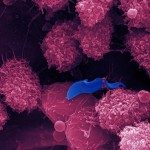The Ecology and Evolution of Antibiotic Resistance (EERA) Unit aims at characterizing factors contributing to the emergence and the dissemination of antibiotic resistance clones in the hospital and in the community. Our research projects focus on Enterobacteriaceae resistant to carbapenems and/or expressing extended spectrum b-lactamases. These isolates represent today one of the most urgent public health threats because of their dramatic increase throughout the world. To address this issue, we are analyzing the evolutionary changes leading to the successful dissemination of specific clones, and the interaction of antibiotic resistant strains with the gut microbiota. We are also searching for the intrinsic factors of these clones contributing to resistance, increased fitness and to a greater capacity to disseminate in the human host and the in the environment. We are combining in silico studies based on comparative genomics, epidemiology, phylogenomics and mathematical modeling with functional studies of bacterial physiology and regulation. The Unit is located at the Institut Pasteur and at the Bicêtre Hospital, and is a joint structure between the Institut Pasteur, the Assistance Public Hôpitaux de Paris (APHP) and the University Paris Sud. Establishing a link between research and clinical cases is a key focus of our research.
Click to view graph
Connections
Members
Former Members
2000
2000
Name
Position
2016
2019
Violette Da Cunha
Post-doc
2016
2019
Elisabeth Sauvage
2016
2019
Pierre-Emmanuel Douarre
2016
2019
Alexandre Santos Almeida
2016
2019
Marie-Dominique Aytac
Administrative Staff
2016
2019
Vesna Mellon
Administrative Staff
2018
2019
Rafaël Patino-Navarrete
Post-doc
2018
2021
Adriana Chiarelli
PhD student
2020
2022
Virginie Guérin
Post-doc
2020
2024
Pengdbamba Dieudonné Zongo
PhD student
Projects
Transversal Project
Publications
Download-
2025Nanoparticle shape is the game-changer for blood-brain barrier crossing and delivery through tunneling nanotubes among glioblastoma cells., Nanoscale 2025 Jan; 17(2): 992-1006.
-
2024[Tunneling nanotubes (TNTs): An essential yet overlooked modality of inter-cellular communication]., Med Sci (Paris) 2024 Nov; 40(11): 829-836.
-
2024Adaptation mechanisms of Clostridioides difficile to auranofin and its impact on human gut microbiota., NPJ Biofilms Microbiomes 2024 Sep; 10(1): 86.
-
2024An antiplasmid system drives antibiotic resistance gene integration in carbapenemase-producing Escherichia coli lineages., Nat Commun 2024 May; 15(1): 4093.
-
2023Chance Favors the Prepared Genomes: Horizontal Transfer Shapes the Emergence of Antibiotic Resistance Mutations in Core Genes., Mol Biol Evol 2023 Oct; 40(10): .
-
2023Determinants of worldwide antibiotic resistance dynamics across drug-bacterium pairs: a multivariable spatial-temporal analysis using ATLAS., Lancet Planet Health 2023 Jul; 7(7): e547-e557.
-
2023A Novel CovS Variant Harbored by a Colonization Strain Reduces Streptococcus pyogenes Virulence., J Bacteriol 2023 Apr; 205(4): e0003923.
-
2022The cnf1 gene is associated with an expanding Escherichia coli ST131 H30Rx/C2 subclade and confers a competitive advantage for gut colonization., Gut Microbes 2022 ; 14(1): 2121577.
-
2022Specificities and Commonalities of Carbapenemase-Producing Escherichia coli Isolated in France from 2012 to 2015., mSystems 2022 Jan; (): e0116921.
-
2021The CovR regulatory network drives the evolution of Group B Streptococcus virulence., PLoS Genet 2021 Sep; 17(9): e1009761.
-
+View full list of publications













